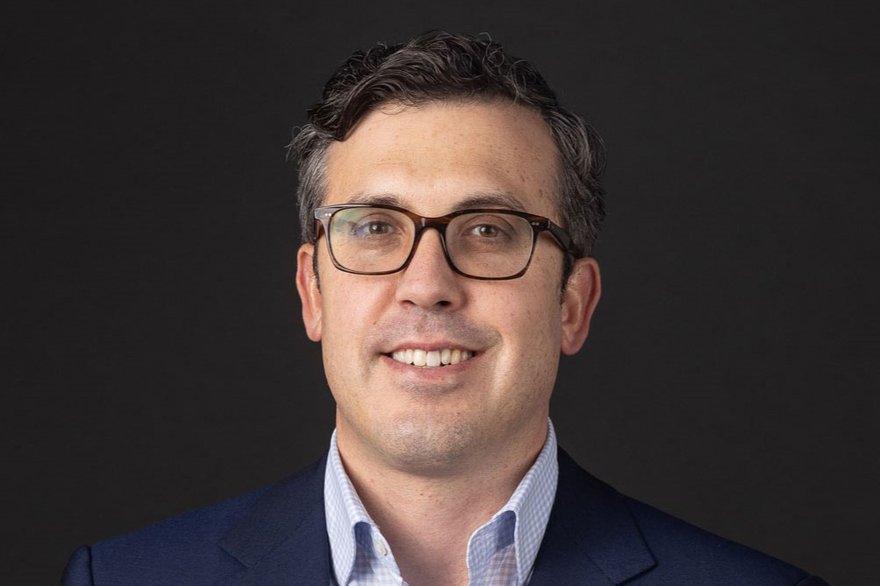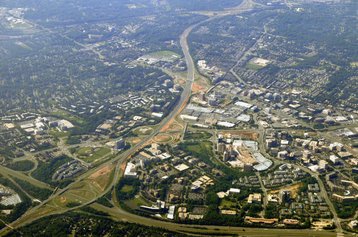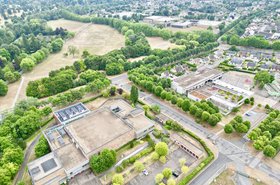Are data centers a tech sector, or a real estate and finance business? The answer is both, of course, but opinions vary on which is the most important of the two essential components of a new facility.
Andy Power is not a tech specialist. He’s come in through finance, but he has strong opinions on the potential for AI, and the shift to hyperscale - and he has some ideas on how to play the data center game.
This feature appeared in Issue 50 of the DCD Magazine. Read it for free today.
Power ascended to the CEO’s seat suddenly at the end of 2022, replacing Digital’s long-term leader Bill Stein, who had been with the company since 2004, and led it since 2014.
Stein was reportedly “fired” from his role, and COO Erich Sanchack was terminated a month later. No reason for the sudden change in leadership has been given - and Power didn’t offer one when we spoke to him.
Power was appointed by the board immediately, and it’s natural to read this as a move to dispel any uncertainties with a safe, immediate internal replacement.
Finance leaders are generally seen as a steady hand, and Power has been involved at Digital nearly as long as Stein.
He joined Digital from Bank of America Merrill Lynch in 2015 as CFO, but his roots at Digital actually go back much further.
“I joined the company about eight years ago, but I came across it almost 20 years ago, at its origins. I was a financial analyst on the IPO.”
Power says he was then a comparatively junior analyst, “literally building the model in Excel and fetching the coffee.”
He was there at “the dawn of the first data center REIT, although at that time it was barely a data center REIT.”
For the next decade or so, his path regularly crossed with Digital Realty. Working for Citigroup and Merrill Lynch, he raised around $30 billion of capital for various clients, (including Paramount Group, the largest REIT IPO), and handled $19 billion of mergers and acquisitions.
Pretty much every time Digital Realty raised public capital, Power was in the room, until he joined the company full time, as CFO, then president, and finally CEO.
Fast and furious
It’s an interesting time to make that step, he says, with big changes in the financial climate, and demand for capacity: “I would say 2023 has been quite the year overall for our world, and quite the year for data centers. It feels a little bit like whiplash on so many fronts. It's been fast and furious, to say the least.”
He explains: “The capital market volatility, the interest rates, the capital supply chains are moving against us, and at the same time demand has accelerated again and again.”
Eight months into the job, he praises his team, and sets goals that are organizational and financial: “Strategy-wise, balance sheet-wise, to essentially accelerate growth for our customers and our stakeholders.”
He wants to strengthen the customer value proposition, focus on parts where Digital can add value for enterprise and hyperscale customers: “Greater pricing power, and organic growth. At the end of the day, too, we need to innovate and integrate.”
The integration he speaks of is tying together a diverse set of data center properties that have been acquired and merged: “We're a product of years and years of M&A. We are building a global platform across 50-plus metropolitan areas, six continents, and 5,000 customers. We have been doing a lot of work tying our systems together, removing the internal friction for our internal customers to help our external customers.”
The company structure has evolved, with Steve Smith from CoreSite coming in to run a newly-founded Americas region. As a former chief revenue officer at CoreSite, Smith also comes from the finance side of data centers.
“We had an APAC region, but we never had an Americas region,” says Power. "It’s to provide consistency for our customers, but also local differentiation - and that been key on the balance sheet.”
There is also a technology side. Power wants to use the company’s ServiceFabric orchestration platform to create facilities with higher density and performance to meet new use cases.
The most important of these is the growth in AI. To support this, the company announced an AI-ready data center in Japan. The KIX13 facility in Osaka is certified ready for Nvidia DGX H100 systems.
This, he says, is just the start of a trend.
The eve of AI industrialization
“The short and sweet on AI is this: it is unlike a lot of the bingo buzzwords that have hit this industry, be it Edge, or crypto, or 5G, or augmented virtual reality. I'm not dismissing them, but artificial intelligence for data centers is real growth in demand.”
In the long term, he envisages a world where new workloads go 50/50 between GPUs and CPUs. “I’m not saying that's all AI necessarily. When you combine that with the growth, that means you basically have an end state where five percent of CPUs are moving to GPUs essentially.”
And it is just beginning: “We've been supporting AI workloads in our data centers for some time, but it's been a small minority of our existing book of business, That’s changing. We're seeing more of it pop up in large-scale training models.”
He says AI is not a “fad that comes and goes” and hopes it is harnessed in an “environmentally friendly, societally proper way.”
And this “early innings” of AI is coming “at a time where the fundamentals are already really in our favor. Given demand remaining robust and supply being constrained due to power generation and transmission, I think this is going to be another wind in our sails for years to come.”
It is happening while the industry is still benefiting from earlier waves of data center development.
“I visit customers and they have server closets, and their own data centers,” he says, “They haven't moved to hybrid IT, they haven't moved to multi-cloud.”
So the cloud is a massive piece of the business, and it’s still growing, he says: “And then AI is this wave on top of it. So these waves and waves of demand keep coming. I don't see a world where we have to empty out our 300-plus data centers to put AI versions in there. I think there'll be matches of GPUs and CPUs with adjacency, and we'll have some new builds dedicated to AI.”
That’s happening because “the AI is using datasets that are living within our four walls today. That proximity and connectivity to those datasets, is going to be important just like the models that AI is running.
“We're just getting started. It's almost a toy at this stage of the game. It is really on the eve of true industrialization.”
A bigger boat of money
Responding to that, he says, will take money: “On the balance sheet, we really need a bigger boat. We need to diversify and bolster our sources of capital.”
He says that bringing in private capital partners will increase Digital’s “runway of growth.”
When we spoke, Power was celebrating a “big, big July.” It entered joint ventures with GI in Chicago, and with TPG in Virginia, alongside the biggest news - a partnership in India where local giant Reliance came in with Digital’s regular partner Brookfield.
“The Indian market is tremendously large and we really wanted someone with boots on the ground and a deep enterprise outreach in the Indian market,” he says.
Power explains further: “We have a view that we're very good at delivering for our customers the design, build operations of data center, and connectivity infrastructure. But we also are very sure that this is a very localized business. And there are certain parts of the world where we just feel we're better partnering with different capital sources or strategic partners.”
That’s not a new idea, he says: “It’s our heritage. When we went to Japan we initially went alone, and then we ultimately entered into a partnership with Mitsubishi called MC Digital Realty that we own 50/50.”
In Latin America, he says, “We found a business that had a lot of heritage on the ground there called Ascenty.”
In buying Ascenty, Brookfield was a natural partner, he says. Brookfield was called Brascan [Brazil-Canada] Investments until 2005, and it was founded in 1899 as the São Paulo Tramway, Light and Power Company.
“We did the same playbook in South Africa,” he says, referring to Digital’s 2022 purchase of a majority stake in local operator Teraco.
He describes these as “strategic partnerships,” where Digital brings the data center expertise, and “our partners are not only bringing capital and ownership, but they're bringing extensions of our salesforce and supply chain, and local know-how.”
Passive majority partners
There’s another kind of deal, where Digital brings in what he calls “passive financial partners” to back big, fully sold or “stabilized” hyperscale developments.
“There are parts of our campuses, where we have filled capacity, we have long-term contracts with our largest highest credit quality customers. And we were recycling capital out of that.”
A deal with Prudential in Singapore, that set up Digital Realty Core REIT there in 2013 followed that model, as did this year’s GI and TPG deals in the US.
“They are both examples of passive majority financial partners that invest alongside us so that we can recycle that capital into the future for our customers,” he says. “We can buy larger land banks, have longer inventory runways, and really future-proof our customers’ growth.”
Wholesale colo and the cloud
The industry seems to be shifting to larger units provided to cloud operators, and those operators are more likely to be built-to-suit and fully handed over to the customer.
“The pendulum kind of goes back and forth on that,” he says, explaining that Digital deals with the top cloud providers, alongside everyone else.
“We have 5,000 customers, and we're adding 130 or 140 each every quarter, but our top customers are the biggest cloud service providers or hyperscalers in the world, that are with us in 20-50 different locations.”
For those big players, he says, “not only are they our top customers, we are their top providers. We supplement, when they do some self-builds.”
He says he’s “proud” of Digital’s strategy: “We didn't go all hyperscale like many of the private companies (or those recently taken private) that really are really catering to just a small handful of customers. And we didn't go pure colocation or connection. It's really just ourselves and Equinix in that arena on a global scale.”
Catering to the full spectrum, he thinks there are benefits of colocation close to the cloud: “There’s synergies for our customers, in this virtuous cycle of hybrid IT.”
He describes Digital’s Ashburn facilities, where “we have multiple buildings, some with colocation suites, with many, many customers and cross-connects, and then we have dedicated data halls and even dedicated buildings.
”We really tried to bring the puzzle pieces, the ingredients where they're needed for data center infrastructure,” he says. “In some markets, the big customers want network-oriented deployments, in other markets they want multiple megawatts in dedicated suites and shared buildings, in other markets they want dedicated buildings with a runway for growth.”
All this, he says, is “essentially just another version of the old school colocation model - just at a massive, massive scale. At the end of the day, sharing a campus is no different to sharing a hall.”
The biggest advantage is at the physical level, he says: “The land, the substation, the supply chain, the generators, the HVACs. There's a customer synergy too, because our enterprise customers are consuming cloud, connecting from one of our suites to another, via physical cross-connects, virtual cross-connects or ServiceFabric.”
Don’t do everything
There are limits to all this: “We don't believe we need to be in every major metro in the whole world,” he says. “We recycle assets out of markets which we don’t see as core to us. So in Germany, we're really concentrated on Frankfurt and Dusseldorf. In France, it's Paris and Marseille.”
In the United States, he says: “Hybrid IT is clustered into major hubs. Philadelphia is between New York and Washington DC, and it didn't really remain an active data center market, even though there's lots of enterprises and CIOs and CTOs and IT associated with it. Those workloads went to New York or went to Ashburn, Virginia.”
He says the major metros let the company cater to small and large IT enterprise customers: “Just because we're in colo, I’m not saying we need to chase every server hugger.”
Chasing net zero
Turning to the sustainability agenda, he says: “I think net zero is obtainable for our industry and I'm proud to raise the bar, because it's so important for our customers and the broader societal impact.”
The size and scale of the industry gives it opportunities and responsibilities, he says. “If we weren't in the full business model with hyperscale, we would be a fraction of our size and we wouldn't have the ability to go with some of these power purchase agreements that essentially bring more green power to the grid.”
He goes on: “We were very early on in this initiative, before it really became in vogue. And honestly, I'm very proud of our accomplishments on multiple fronts. We've put out science-based targets which we've made great progress on.
“We've been really moving the needle when it comes to renewable energy which, in my opinion, is going to be the largest gating item to net zero.”
Digital has a lot of power purchase agreements (PPAs) for low-carbon energy: “We take a different approach to some of our competitors - we don’t really do RECs [renewable energy certificates], or financial derivatives.”
A few percent of Digital’s capacity is covered by RECs, where there is no option: “Usually we do them where a customer is assisting on that requirement. But I want a way that provides true additionality to the grid - and the financial derivative market can be used and abused.”
PPAs are long-term contracts to establish the creation of new solar and wind farms, but it could go further.
“In some less sophisticated markets, we’d invest in the actual solar farms,” he says. He likes the idea that “when I'm signing a contract for a wind turbine, or a solar farm, I can go visit it myself. I know that we're doing something that's really making a difference.
“So that's a long-winded way of saying I'm proud of our accomplishments - but we're not done yet. We're not 100 percent green, but we're charting a path to get there.”
Diversity and skills
Rapid expansion has brought a skills shortage, he says: “This industry has grown from the backwaters to global asset class at an aggressive pace. The size and scale this industry - and this company - has come to in 20 years is phenomenal. And it has outstripped the talent capabilities both at the top and the bottom of organizations.”
More diverse hiring will improve the talent pool, he says, and “I'm proud of what we've done at both ends but I also think we’ve got continuing more work to do.”
Mary Hogan Preusse is chairwoman of Digital’s board, and remains one of a very few chairwomen in the Standard & Poors 500, says Power.
“What keeps us up at night is how we bring more talent into our industry through the ranks all the way down to the engineers that are walking the halls of our data centers,” he says.
To address that, he says, “we've tapped into numerous employee resource groups, be it veterans groups, diversity groups, to bring more talent into the pool.”
He’s pleased with progress, given where the industry has come from, but still the new diverse hires don’t match the growth: “We're bringing on new capacity, and it's outstripping the folks that raise their hand and say I want to go work in the data center industry. I think we as an industry have a lot of growing up to do and have to solve that problem at scale.”
He admits that the industry is short on diversity in front-line staff: “We need to do more. We’ve got to tap into technical schools and engineering programs.”
Within the company, he says “we really try to organically create employee resource groups around each of the diversity categories, and spend executive time with those groups to champion the inclusion and diversity of our workforce - and making our 3,000 plus employees the ambassadors to bring more talent into the company.”
He reckons he can learn from being with different kinds of people: “When I somewhat reconstituted the leadership team here, it included a mix of internal promotions, and outside talent, with a diversity of backgrounds, international and domestic.
“My roots come from finance, and I certainly want to surround myself with people that fill the holes in my background, and push me, on the technology front, on the infrastructure front, on the environmental front. Different folks bring more to the table.”
So how does Power play the data center game?
“The team at Digital is not done yet,” he says. “We didn't head for the locker room at the halftime of 2023 for good. We're back on the field ready to deliver some more great wins.”







